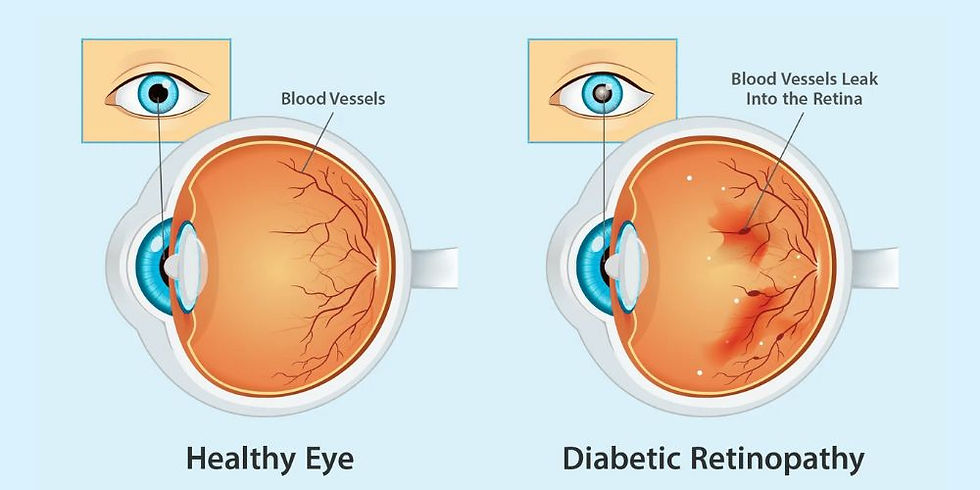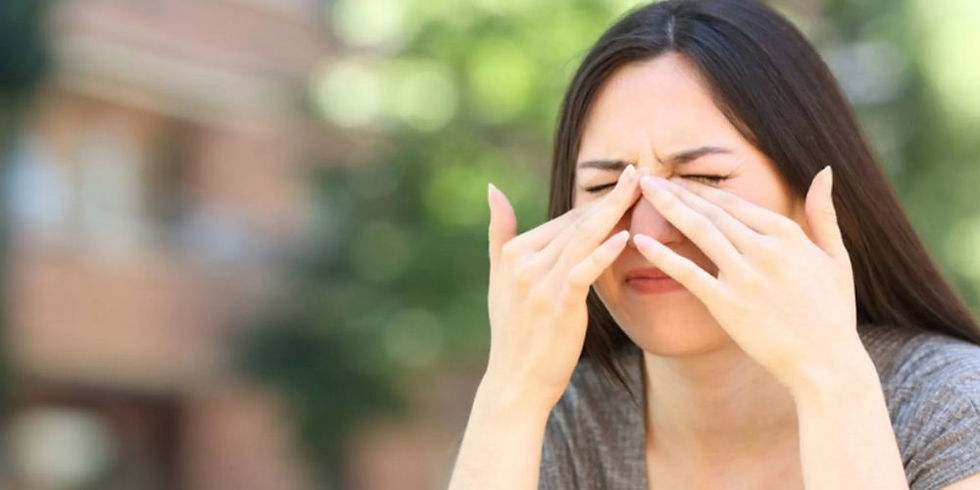How to Protect Your Eyes from Delhi NCR’s Air Pollution - Prevention Tips by Expert
- Arunodaya Deseret Eye Hospital
- Nov 5
- 5 min read

Air pollution in the Delhi-NCR region isn’t just a respiratory threat-it’s now clear that the polluted air is taking a significant toll on our eyes too. If you’re living, working or commuting in this region, it’s crucial to understand how the air around you affects your eye health-and what you can do to guard your vision. In this article, we’ll walk through how to protect your eyes from Delhi NCR’s air pollution, share expert-backed prevention tips, and highlight who needs extra care.
Understanding the Air Pollution Crisis in Delhi NCR
The scale of air pollution in Delhi NCR is alarming. For instance, during the winter of 2024-25, Delhi recorded an average fine particulate matter (PM2.5) value of 159 µg/m³, making it the most polluted city in India in that season.Moreover, in January 2025, Delhi logged an average PM2.5 concentration of around 165 µg/m³, and for 23 of the 31 days the air quality was in the “Very Poor” category. Real-time tracking shows that on many days, the Air Quality Index (AQI) in Delhi climbs well above 300 (“Very Poor”) and even into “Severe” territory, making outdoor conditions dangerous for everyone. What this means: The air you breathe every day may be laden with fine particulates (PM2.5, PM10), nitrogen oxides (NO₂), ozone (O₃) and other pollutants that not only affect your lungs, but your eyes too.
How Polluted Air Impacts Your Eyes
Short-term irritation
When the air is thick with pollutants, many people report burning, itching, watering or dryness in the eyes. These are the first signs that your ocular surface is getting stressed. Research indicates that for every 10 µg/m³ increase in PM10, the risk of eye infections rises by about 0.33%.Polluted air can cause conjunctival irritation, tear-film instability (leading to dry eyes) and corneal surface stress.
Long-term eye damage
Prolonged exposure to high pollution loads has been linked to more serious eye conditions. A study found a positive correlation (r=0.54) between PM2.5 emissions and ophthalmic outpatient visits in India.Other research warns that exposure to dusty, polluted air can accelerate degenerative conditions like cataracts, glaucoma and corneal opacity.In short: what starts as simple irritation can develop into chronic issues if you neglect eye protection.
Who Needs Extra Eye Care During High Pollution
Some groups are more vulnerable than others when it comes to eye damage from pollution:
Children & teenagers: Their eyes are still developing and they often spend time outdoors. Pollutants can influence ocular surface health and may have longer-term consequences.
Elderly people and those with pre-existing eye conditions: People already suffering from glaucoma, dry-eye syndrome or previous corneal damage are at higher risk of worsening.
Commuters, outdoor workers, traffic police, construction staff: Frequent exposure to ambient pollution and dust means repeated hits to the eyes.
People with allergies or respiratory issues: When the air irritates your lungs or triggers allergies, you’re likely to rub your eyes more, worsening the risk of infection or damage.
If you fall into any of these categories, you should adopt protection measures now, not later.
Top 7 Prevention Tips to Protect Your Eyes
Here are expert-suggested steps you can take to shield your eyes in polluted environments.
Tip 1: Monitor air-quality & avoid high-pollution outdoor time
Check the AQI before heading out. On days when AQI climbs above 200 (Very Poor) or worse, try to limit outdoor exposure-especially in the early morning or late evening when inversion layers trap pollution.Plan errands, school runs or jogs when air quality is better.
Tip 2: Use protective eyewear & masks
While masks (N95/KN95) help protect your lungs, eyewear with a snug fit can reduce the amount of particulate matter reaching your eye surface. Wrap-around sunglasses or pollution-specific goggles help too.
Tip 3: Create a clean-air indoor environment
Even indoors, polluted air seeps in. Use a HEPA filter air purifier, keep windows closed during high-pollution days, and wipe eye surfaces with a clean, damp cloth to remove deposited dust at day’s end.
Tip 4: Use eye drops / lubricants wisely
If your eyes feel dry or gritty, consider using preservative-free lubricating eye drops (artificial tears) to flush out irritants. Consult your ophthalmologist for suitable options.Avoid red-eye remedies that mask irritation without addressing the cause.
Tip 5: Maintain good eye hygiene & rest
Keep your hands clean, avoid rubbing eyes (which can introduce pollutants or allergens), and get enough sleep so your eyes can recover each night. Use humidifiers if indoor air is too dry.
Tip 6: Eat a diet that supports eye health
Foods rich in antioxidants (like carrots, leafy greens, blueberries), omega-3 fatty acids (fish, flaxseed) and vitamins A, C & E help maintain eye-tissue integrity and may improve resilience against environmental stress.
Tip 7: Visit an eye-care professional regularly
If you notice persistent redness, burning, blurred vision, increased sensitivity to light or new floaters, see an ophthalmologist. Early intervention prevents long-term damage.
Special Tips for Commuters & Outdoor Workers
Choose less-polluted routes (wind-facing, fewer vehicles, green cover).
Limit outdoor breaks during peak pollution hours (morning rushed traffic, late evening).
At work sites, use protective eyewear and screens where possible.
Rinse your eyes (clean water) immediately after heavy exposure to dust/smog.
Stay extra hydrated-well-hydrated tissues handle pollutant stress better.
What to Do When You Notice Eye Symptoms
If you experience:
Persistent eye redness, burning, watering or itching
Blurry vision or difficulty focusing
Increased light sensitivity or discomfort
Grittiness or foreign-body sensation
…then treat it as a warning sign. Schedule an eye-check, describe your pollution exposure to your doctor, and take steps to reduce outdoor exposure until your eyes recover.
Staying Positive: Eye Health in a Polluted City
Living in a high-pollution zone like Delhi NCR doesn’t mean you’re powerless. With awareness, daily habits and protective tools, you can guard your eyesight. Think of eye-care as part of your health-armor-just like fitness or diet. Keep at it, and you’ll build resilience against the smog.
FAQs
Q1: Can air pollution really cause cataracts or glaucoma?
Yes. Research shows long-term exposure to fine particulate matter (PM2.5) is linked with degenerative eye conditions including cataracts and glaucoma.
Q2: How often should I use eye drops if my eyes feel irritated?
Use preservative-free lubricating drops as needed-typically 2-4 times a day when symptoms appear. If irritation persists beyond a week, consult an eye-care professional.
Q3: Will sunglasses help protect my eyes from pollution?
Yes. Wrap-around sunglasses or pollution-goggles reduce the number of particulates entering your eyes. They’re a good adjunct to masks and indoor air-cleaning.
Q4: Are outdoor sports safe on high-pollution days?
Not ideal. When AQI is above 200 (“Very Poor” or worse), avoid strenuous outdoor activities. Choose indoor alternatives or postpone until air quality improves.
Q5: Does indoor air get polluted too? What can I do?
Yes - outdoor pollution infiltrates homes. Use a HEPA air purifier, keep vents closed during smog episodes, and clean surfaces regularly to reduce indoor deposition of pollutants.
Q6: When should I see an eye-doctor because of pollution exposure?
If you experience persistent redness, burning, blurred vision, increased sensitivity to light, or new floaters, don’t wait-visit an ophthalmologist. Tell them about your pollution exposure, so it’s factored into diagnosis.
Protecting your eyes from the toxic air of Delhi NCR is essential. With pollution levels remaining alarmingly high-PM2.5 averages of 159 µg/m³ in winter 2024-25, and frequent “Very Poor” to “Severe” AQI days-eye health can no longer take a back-seat.By following the prevention tips above, staying vigilant about symptoms, and supporting broader air-quality efforts, you’ll be giving your eyes the best chance to stay healthy and resilient in challenging conditions. Don’t wait-start protecting your vision today.










Comments